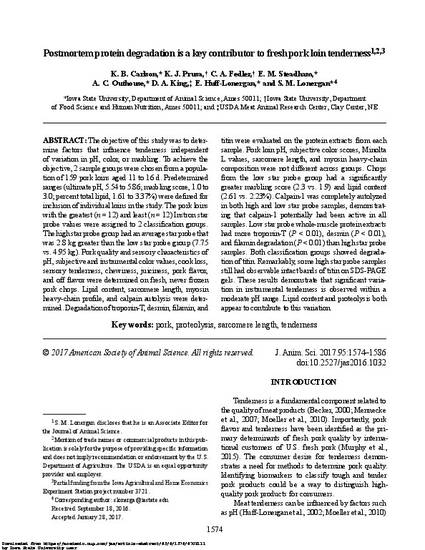
The objective of this study was to determine factors that influence tenderness independent of variation in pH, color, or marbling. To achieve the objective, 2 sample groups were chosen from a population of 159 pork loins aged 11 to 16 d. Predetermined ranges (ultimate pH, 5.54 to 5.86; marbling score, 1.0 to 3.0; percent total lipid, 1.61 to 3.37%) were defined for inclusion of individual loins in the study. The pork loins with the greatest (n = 12) and least (n = 12) Instron star probe values were assigned to 2 classification groups. The high star probe group had an average star probe that was 2.8 kg greater than the low star probe group (7.75 vs. 4.95 kg). Pork quality and sensory characteristics of pH, subjective and instrumental color values, cook loss, sensory tenderness, chewiness, juiciness, pork flavor, and off flavor were determined on fresh, never frozen pork chops. Lipid content, sarcomere length, myosin heavy-chain profile, and calpain autolysis were determined. Degradation of troponin-T, desmin, filamin, and titin were evaluated on the protein extracts from each sample. Pork loin pH, subjective color scores, Minolta L values, sarcomere length, and myosin heavy-chain composition were not different across groups. Chops from the low star probe group had a significantly greater marbling score (2.3 vs. 1.9) and lipid content (2.61 vs. 2.23%). Calpain-1 was completely autolyzed in both high and low star probe samples, demonstrating that calpain-1 potentially had been active in all samples. Low star probe whole-muscle protein extracts had more troponin-T (P < 0.01), desmin (P < 0.01), and filamin degradation (P < 0.01) than high star probe samples. Both classification groups showed degradation of titin. Remarkably, some high star probe samples still had observable intact bands of titin on SDS-PAGE gels. These results demonstrate that significant variation in instrumental tenderness is observed within a moderate pH range. Lipid content and proteolysis both appear to contribute to this variation.
Available at: http://works.bepress.com/elisabeth_huff-lonergan/128/

This article is published as Carlson, K. B., K. J. Prusa, C. A. Fedler, E. M. Steadham, A. C. Outhouse, D. A. King, E. Huff-Lonergan, and S. M. Lonergan. "Postmortem protein degradation is a key contributor to fresh pork loin tenderness." Journal of animal science 95, no. 4 (2017): 1574-1586. doi: 10.2527/jas.2016.1032.